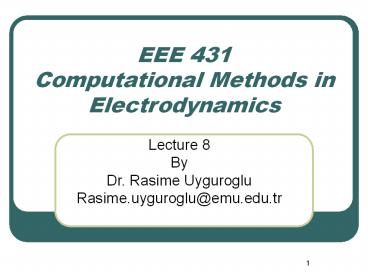EEE 431 Computational Methods in Electrodynamics - PowerPoint PPT Presentation
Title:
EEE 431 Computational Methods in Electrodynamics
Description:
EEE 431 Computational Methods in Electrodynamics Lecture 8 By Dr. Rasime Uyguroglu Rasime.uyguroglu_at_emu.edu.tr – PowerPoint PPT presentation
Number of Views:144
Avg rating:3.0/5.0
Title: EEE 431 Computational Methods in Electrodynamics
1
EEE 431Computational Methods in Electrodynamics
- Lecture 8
- By
- Dr. Rasime Uyguroglu
- Rasime.uyguroglu_at_emu.edu.tr
2
FINITE DIFFERENCE TIME DOMAIN METHOD (FDTD)
3
FINITE DIFFERENCE TIME DOMAIN METHOD (FDTD)
- Basic FDTD Requirements
- Space Cell Sizes
- Time Step Size
4
FINITE DIFFERENCE TIME DOMAIN METHOD (FDTD)
- Space Cell Sizes
- Determination of the cell sizes and the time step
size are very important aspects of the FDTD
method. Cell sizes must be small enough to
achieve accurate results at the highest frequency
of interest and must be large enough to be
handled by the computer resources.
5
FINITE DIFFERENCE TIME DOMAIN METHOD (FDTD)
- Space Cell Sizes
- The cell sizes must be much less than the
smallest possible wavelength (which corresponds
to the highest frequency of interest) to achieve
accurate results. - Usually the cell sizes are taken to be smaller
than , .
6
FINITE DIFFERENCE TIME DOMAIN METHOD (FDTD)
- Time Step Size
- The time step size , required for FDTD algorithm,
has to be bounded relative to the space sizes.
This bound is necessary to prevent numerical
instability.
7
FINITE DIFFERENCE TIME DOMAIN METHOD (FDTD)
- Time Step Size
- For a 3-Dimensional rectangular grid, with v the
maximum velocity of propagation in any medium the
following well-known stability criterion
8
FINITE DIFFERENCE TIME DOMAIN METHOD (FDTD)
- Excitations
- At t0 all fields are assumed to be identically 0
throughout the computational domain. - The system can be excited either by using a
single frequency excitation (i.e. sine wave) or a
wideband frequency excitation (i.e. Gaussian
Pulse)
9
FINITE DIFFERENCE TIME DOMAIN METHOD (FDTD)
- Single Frequency Plane Wave
- A desirable plane wave source condition, for the
three dimensional case, applied at plane
(near y0) is
10
FINITE DIFFERENCE TIME DOMAIN METHOD (FDTD)
- Analytical expression of the Gaussian pulse
- Where, T is the Gaussian half-width and
- is the time delay. Then the computer code
11
FINITE DIFFERENCE TIME DOMAIN METHOD (FDTD)
- Absorbing Boundary Conditions
- The FDTD method has been applied to different
types of problems successfully in
electromagnetics, including the open region
problems.
12
FINITE DIFFERENCE TIME DOMAIN METHOD (FDTD)
- In order to model open region problems, absorbing
boundary conditions (ABCs) are often used to
truncate the computational domain since the
tangential components of the electric field along
the outer boundary of the computational domain
cannot be updated by using the basic Yee
algorithm .
13
FINITE DIFFERENCE TIME DOMAIN METHOD (FDTD)
- Differential based ABCs are generally obtained by
factoring the wave equation and by allowing a
solution, which permits only outgoing waves. - Material-based ABCs, on the other hand, are
constructed so that fields are dampened as they
propagate into an absorbing medium.
14
FINITE DIFFERENCE TIME DOMAIN METHOD (FDTD)
- We will consider ABCs developed by A.
Taflove. - The conditions relate the values of the field
components at the truncation planes to the field
components at points one or more space steps
within the solution region (lattice)
15
FINITE DIFFERENCE TIME DOMAIN METHOD (FDTD)
- For One dimensional Wave Propagation
- Assume that waves have only Ez and Hx components
and propagate in the ve and ve y directions,
then - When the lattice extends form y0 to yj
16
FINITE DIFFERENCE TIME DOMAIN METHOD (FDTD)
- One dimensional free space formulation
- Assume a plane wave with the electric filed
having Ex, magnetic field having Hy components
and traveling in the z direction.
17
FINITE DIFFERENCE TIME DOMAIN METHOD (FDTD)
- Maxwells Equations become
18
FINITE DIFFERENCE TIME DOMAIN METHOD (FDTD)
- Taking central difference approximation for both
temporal and spectral derivatives

